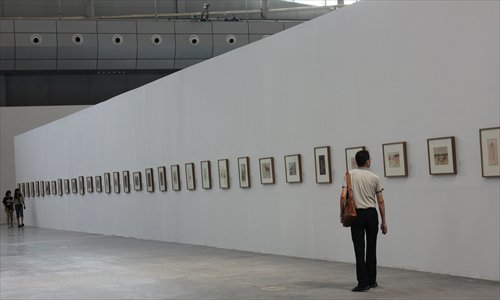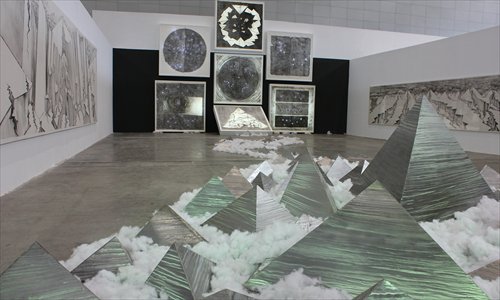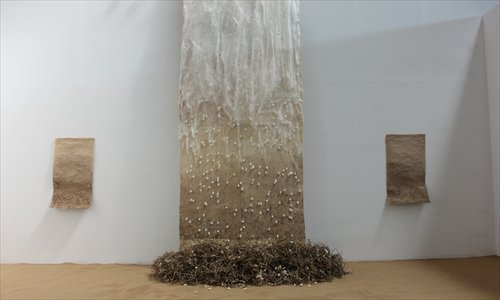HOME >> ARTS
Expanding horizons
By Li Jingjing in Urumqi Source:Global Times Published: 2014-7-3 20:28:01
Arts Biennale looks to inject creativity into Xinjiang’s art scene

The exhibition hall of The 1st China Xinjiang International Arts Biennale Photo: Li Jingjing/GT

Trying to communicate with the Horizon: The Theater of Universe | The Flame of Ice Photo: Li Jingjing/GT

Mulberry & Silkworms No.2-1 by He Weili Photo: Li Jingjing/GT
Economic trade isn't the only thing connecting countries along the Silk Road, the exchange of culture and art has also become increasingly regular thereby creating close knit bonds between participants.In Urumqi, capital of the Xinjiang Uyghur Autonomous Region and a key hub connecting China with West Asia and regions beyond, The 1st China Xinjiang International Arts Biennale, a month-long exhibition celebrating international cultural exchange, kicked off on June 25.
Walking along the five-kilometer-long route through the exhibition hall in the Xinjiang International Convention & Exhibition Center, a grand view of fantastic art works from countries including China, Kazakhstan, Turkey, India, Uzbekistan, Kyrgyzstan, Iran, Croatia and Italy leaps into one's sight.
With the main exhibition - entitled Encounterance on the Silk Road - showing Silk Road-themed works from 18 countries, the biennale also includes one special exhibition, two theme exhibitions and three peripheral exhibitions all adding up to an impressive display of a large variety of traditional and contemporary art works, such as sculptures, installation art and video art.
Normally, people picture Xinjiang as a place with breathtaking scenery, interesting ethic customs and minority groups that have their own form of signing and dancing. Now, with this event, it has also become home to international art from numerous countries along the Silk Road.
Xinjiang inspiration
The art of making Xinjiang Uyghur mulberry paper is regarded as a living fossil of papermaking technology and has been listed among China's national intangible cultural heritages. Talking to the Global Times, Xinjiang artist He Weili explained how his visit with an elderly Uyghur mulberry papermaker led to his epiphany to create his installation artwork Mulberry & Silkworms No.2-1.
In his work, silk, silk cocoons, mulberry tree bark and the desert all connect harmoniously with each other. According to entries recorded in the Great Tang Records on the Western Regions by the famous Tang Dynasty (618-907) monk Xuanzang, silk was originally not native to western regions like Xinjiang, but rather introduced to the region after a princess from China's central plains who married a western region king brought silk cocoons here. Since then, Mulberry trees have been widely cultivated throughout the region.
"This shows an internal relationship. Through the wisdom of humanity, things that appear different are actually connected. Just like how no one could have imagined the desert, mulberry trees and silk could be connected," He told the Global Times.
For Beijing artist Xing Gang, it was Xinjiang's natural scenery that inspired his creation.
"On April 5, I climbed the No.1 glacier on the Tianshan Mountains, it was at an altitude of 4,280 meters and temperatures were minus 17 C," Xing said. "At the time the freezing cold and the extreme lack of oxygen put my life in danger, but I think it was totally worth it. Facing the power and vastness of nature, I felt like a mere mote of dust."
In Xing's installation work combining metal and ink paintings Trying to Communicate with the Horizon: The Theater of Universe | The Flame of Ice, pyramids surrounded by cotton give an impression of giant icebergs surrounded by clouds while scenic landscape paintings in black ink hang on the surrounding walls. Altogether this work contains 69 metal installations and seven ink paintings.
He told the Global Times that he exhibited similar metal installations in Beidaihe, Hebei Province. The coastal city inspired him to exhibit the pyramid shaped pieces in the water, which transformed into an image of mountains in the sea. Coming to Xinjiang, he was inspired to use cotton instead of water to better connect with Xinjiang's natural features.
Even the stories of artists who are no longer with us are being shared at the exhibition. A large themed exhibition entitled Situ Qiao in Xinjiang contains a vast collection of works by the late artist Situ Qiao during his time in Xinjiang. A Cantonese artist, he spent a long period of time in the region during 1940s. Fascinated by the cultural here, he created numerous works portraying the local people and the customs he saw. By the time he left Xinjiang, he looked just like any other Uygur man, with a full beard and an Islamic hat.
Through all these works, artists attempt to tell the stories of their unique relationship with Xinjiang.
Inspiring creativity
"What Xinjiang lacks is artistic creativity. Therefore how to increase the creativity of the people here is a fundamental aim of the exhibition," Zhang Zikang told the Global Times. As a deputy director general of the Cultural Department of the Xinjiang Uygur Autonomous Region, he has witnessed first hand what he considers the closed off and conservative state of art in Xinjiang, which has driven him to establish such a grand art exhibition.
He said that due to geographic and economic reasons, many artists in Xinjiang haven't had a chance to experience art from other areas. Therefore it is his hope that by bringing various different styles of art works from successful artists in other regions he can help lead the people in Xinjiang to think more creatively.
"The crucial thing is to let this exhibition play an educational role, have it promote an active way of thinking that can inspire people to actively ponder upon art and improve aesthetic consciousness," Zhang said.
Having organized many exhibitions in big cities as a curator such as Beijing, his usual approach to exhibitions is more academically orientated. Yet for this exhibition in Xinjiang, he decided to try and do something that would allow different types of people to get involved. To this end he has brought works covering a broad spectrum of styles. For older visitors there are traditional Chinese paintings from ancient dynasties, while younger spectators can enjoy contemporary oil paintings. And for kids, they have a chance to play with video art work, such as Mirage, a work by American artist Dan Collins where visitors step on lights projected on the ground. In one section stepping on a picture of a river causes it to turn into the Gobi Desert, and after they leave it returns to being a river.
"Works like this provoke people's interest. Once they're interested, they tend to want to know more and ask more questions about other art works as well," Zhang said.
This is not Zhang's first exhibition in Xinjiang. In 2012, he organized the The 1st China-Xinjiang Contemporary Art Biennale, an exhibition gathering the works of top Chinese artists. Although an autonomous-region-level exhibition, it laid a solid foundation for him to organize this current exhibition, which is supported by the Ministry of Culture and the people's government of the Xinjiang Uyghur Autonomous Region.
Posted in: Art